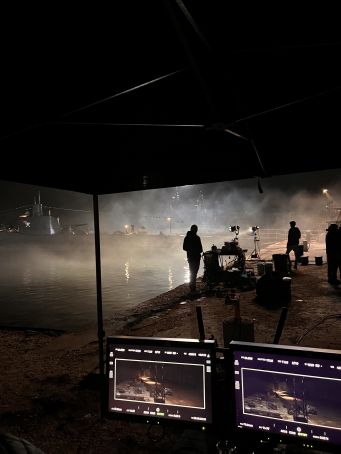Italian movie revolutionises Visual Effects
The strikes in the U.S. film industry have given the independent Italian production Comandante a chance in the spotlight.
Selected to open the 80th Venice International Film Festival, it is the revolutionary way that the Visual Effects were developed that makes the film truly stand out.“Italy is the only place where we could do this”, explains VFX Designer Kevin Tod Haug, “Hollywood would have never allowed us to do something so out- of- the-box.”
As a veteran Visual Effects Designer (his credits include Fight Club and Quantum of Solace), Haug has reinvented the wheel more than once. However, the budget and time constraints, combined with the reputable artistry of Italian production created the perfect conditions for establishing what Haug has coined Near Real Time VFX.
In very simple terms, Visual Effects are computer- generated images that add something to a scene in a movie that does not exist in reality where it can be photographed. For the film Comandante, this meant WWII submarine battles in the open water.
Generally, the majority of Visual Effects work happens in post- production, when all of the elements of a film come together. This process can take months - or even years - is incredibly expensive and effectively divides the process, creating VFX that are cut off from the earlier planning and shooting phases of making the movie.
The reigning wisdom is that the preparation phase of a move, which is dominated by Art department via various forms of Computer Aided Design (CAD) and the actual shooting of the movie, which is lead by the Camera department, are separated by the ‘Analogue Abyss’ where all the CAD plans, references, pre-visualizations… are ‘printed out’ into sets and then photographed with the actors. Then, in what is usually referred to as the ‘Digital Divide’, all of that is re-digitized in the post process in order to finish the movie.

Haug has coined the term Near Real Time to describe the innovative method. This is the first time in filmmaking history that all the useful data from a camera and lens (including its position in space) has been merged in real-time with the Computer Graphics pipeline to be used on set and all the way through final delivery.
It allows filmmakers to be informed over the final movements within shots, and, as in the case of Comandante, saves both time and money while also enhancing the artistic quality of the image.
The presentation of Comandante at the 80th Venice International Film Festival will mark a paradigm shift in the way producers approach VFX.
It seems like no coincidence, as it follows in the tradition of Italy being an innovator of cinema. Just take Neorealism for example. Neorealism came out of the Italian filmmaker’s necessity to create despite limited resources. It is now recognized as one of the most influential film genres in history.
Italians aren’t interested in making a Marvel movie. The shift required to move away from what Haug describes as “post- driven movie making,” where VFX production happens mainly after the movie has been shot and edited, back to “Old School filmmaking,” where the creative focus stays with the director and his key collaborators - think of how any current Marvel movie does their VFX vs 2001: A Space Odyssey or the original Blade Runner” - could have only happened in Italy.
It is a place teeming with talent willing to adapt to new ways of doing things, positioned to be accessible to the technological advancements in camera, CG software and metadata recovery that are happening in Europe (Ireland and France), and the vision to tell a story with what they’ve got.
Comandante recounts the true story of WWII Italian submarine commander Salvatore Todaro and his crew, who saved enemy sailors after sinking their merchant ship. By performing this perilous act, the commander draws a line between what it means to be human and the brutality of war.
The film reminds us of how maritime law is based on values and ethics. The Visual Effects in the movie help convey the message through intense naval battles and uncertain seas.
Comandante will premiere on Wednesday, August 30, 2023 in the Sala Grande of the Palazzo del Cinema, on the opening night of the 80th Venice International Film Festival. Comandante is an Indigo Film and O' Groove production with Rai Cinema, Tramp LTD, V-Groove, Wise Pictures, in association with Beside Productions, in collaboration with the Italian Navy and Cinecittà, and will be distributed by 01 Distribution.


















